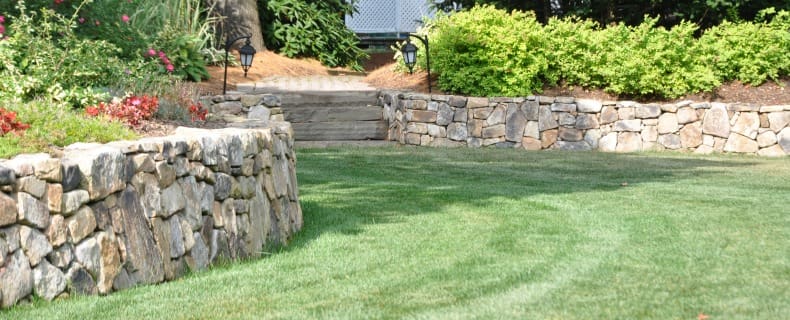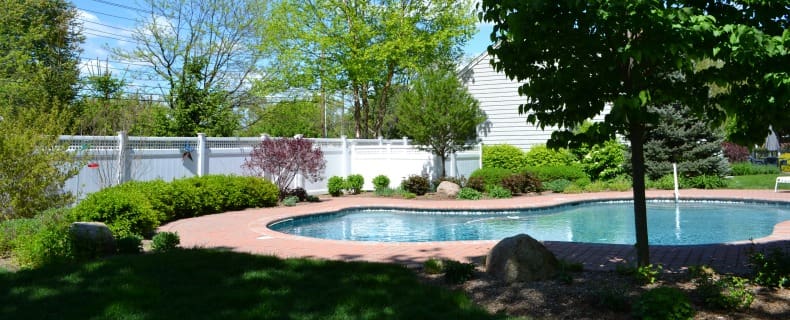A green, healthy lawn requires a year-round commitment, but it’s essential to pay close attention to seasonal lawn care throughout the year.
Each season has specific lawn care and maintenance requirements that help your lawn look its best year-round.
Proper lawn care and maintenance in one season leads to benefits for the next season.
If your lawn’s seasonal needs are neglected, your lawn can suffer the consequences of unhealthy soil, weak plant roots, poor growth patterns, abundant weeds, harmful insects and outdoor pests.
To keep your Bergen County lawn lush, green and healthy all year, follow this monthly checklist for best seasonal lawn care results.

January
January in Northern New Jersey is typically a cold month with freezing temperatures and winter storms that bring rain, snow and ice.
In January, most plant growth is dormant and your grass stops growing, so your grass and plants rely on strong root systems to store essential nutrients.
If they don’t store up nutrients, they will have a difficult time surviving winter temperatures or producing healthy new growth in the spring.
Although winter seasonal lawn care is minimal, your lawn still needs proper care and maintenance.
Regular Lawn Care and Maintenance – Regular lawn care and maintenance is important during the winter months to keep a well-maintained appearance for your home.
Once every week or two, clear away any trash or debris like fallen tree limbs and twigs that have fallen on the lawn. Any debris that’s left on your lawn too long can cause dead spots in your grass, especially during snowfall when grass lacks oxygen.
Rake up excess leaves, especially wet ones that contribute to lawn diseases and insects. Sweep, clean and edge all hardscaped driveways, sidewalks and walkways to keep a neat appearance.
With minimal lawn care in January, it’s a good time to plan for lawn and garden renovations you want to tackle in the Spring.
February
February may show glimpses of more sunshine, but temperatures in Bergen County are still low.
It’s important to continue regular maintenance and address overgrown trees and shrubs.
Although your lawn, trees and plants are growing at a much slower rate, you should protect your lawn and avoid winter overgrowth.
Foot Traffic – Avoid excessive foot traffic on your lawn during January and February, especially if it’s covered in snow. Although grass is naturally resilient, cold winter weather creates extra stress on grass roots.
Cool-season grasses, commonly found in Northern New Jersey lawns, usually turn brown and go dormant during the winter, then turn green again in the spring with proper care and fertilization.
Excessive winter foot traffic on your lawn will weaken the grass and make it harder for grass to recover when spring rolls around.
Pest Control – If you leave your lawn too tall during the winter, it will be an invitation to a variety of outdoor insects and pests like field mice, rats, gophers, snakes and burrowing animals that want a warm place to sleep.
Mice can destroy large parts of your lawn by building nests. They create dead spots where they spend all of their time, as well as pulling up large amounts of grass to build their nests.
These types of outdoor pests can quickly destroy your lawn and create possible health concerns for your children and pets.
During the winter, important seasonal lawn care includes preventing overgrown grass, as well as plants, shrubs and trees.
March
March is a busy month for seasonal lawn care needs. Warm weather brings sunshine and spring showers that create abundant new growth.
Your grass, as well as your landscape plants, shrubs and trees all begin to grow much faster, so proper lawn care and maintenance is essential in March.
Yard Cleanup – When the last signs of winter frost are gone, focus on cleaning up your yard to get rid of winter debris.
Rake up dead, dry leaves and remove any fallen twigs, branches and trash that’s blown into your yard.
Get rid of damp or wet leaves quickly, as they can smother new grass growth. Give your grass a good mowing weekly to prevent overgrowth.
Fertilization – March is a prime time to fertilize your lawn. After winter, grass and plants need essential nutrients like nitrogen, phosphorus, potassium and iron for strong roots and healthy new growth.
Choose a light, slow-release or organic type fertilizer that won’t burn your lawn. Your landscape professional help you choose the best type of fertilizer.
Weed Control – Spring brings new growth, but it also brings abundant weeds. Aggressive weeds like crabgrass, thatch, dandelions, foxtails and creeping charlie typically invade at the onset of warm weather.
If not controlled, aggressive weeds can take over your entire lawn very quickly.
In March, you need to apply a pre-emergent herbicide to prevent weeds from invading your lawn.
Pest Control – Warm weather brings out a variety of insects and outdoor pests that can invade your lawn and landscape and munch on fresh, new spring growth.
In March, talk to a Bergen County landscape professional, like Borst Landscape & Design, about organic pest control solutions and an Integrated Pest Management Program (IPM) for your home.

April
In April, when warm days clearly indicate that spring has arrived, seasonal lawn care should include continued weekly lawn care and maintenance like mowing and weeding, as well as soil testing and planting new spring plants.
Soil Testing – In April, after the ground has warmed up, it’s important to do a soil test to determine your soil’s pH balance.
The type of soil you have, acid or alkaline, has an impact on your grass growth and seasonal lawn care requirements. Sandy soils drain quickly and don’t hold much moisture, while clay soils hold moisture, but don’t let in much oxygen.
To do a soil test, you can purchase a soil test kit at a local garden or home improvement store, or call a landscape professional to do the test.
If you hire a Bergen County landscape company for year-round lawn care and maintenance, a soil test may be included in annual services.
Planting – After frost is gone, you can begin planting colorful annuals and perennials in your landscape.
When selecting plants, you need to consider your existing soil type, light conditions, water requirements and planting locations that will impact growth and maintenance requirements.
For a beautiful spring and summer garden, talk to the garden designers at Borst Landscape & Design about choosing the right plants and proper plant care.
May
In May, as temperatures continue to climb, continue your regular lawn care and maintenance to keep your lawn and landscape well-maintained and free of weeds and overgrowth.
Additional seasonal lawn care should include mulching, weed control and pruning in your landscape.
Mulching – May is a good time to add mulch to flower beds and around shrubs and trees. Mulch will help your soil to stay cooler during summer months.
Organic mulches naturally decompose and add many benefits to your lawn and landscape areas.
They will promote: moisture retention in the soil; even soil temperatures; protection from soil erosion; less soil compaction; less weed growth; and a finished appearance for your landscape.
Weed Control – To prevent summer weed growth, you need to apply post emergence broadleaf herbicides to your lawn.
If needed, start post-emergence control of crabgrass, goose grass or nutsedge near the end of May.
Talk to a Bergen County landscape professional about the advantages and benefits of organic herbicides for your lawn.
Pruning – May is a good time to prune plants, shrubs and trees since many have reached maximum foliage growth.
Prune your spring-flowering plants right after blooms fade, and summer-flowering plants and trees before they start to bloom.
If plants are severely damaged or dying, it’s best to replace them.
June
June is officially the beginning of summer, and it brings lots of sunshine and insects to your lawn.
In addition to regular lawn care and maintenance, June seasonal lawn care should focus on proper mowing and watering and prevention of lawn diseases.
Mowing – During the summer months, you should increase the mowing height on your lawn mower. Leaving your grass a little longer in the summer sun and heat will protect soil and grass roots from drying out quickly.
Follow the mowing rule – only cut off the top one-third of grass blades. You can also leave grass clippings on the lawn for extra nutrients.
Watering – Regular watering during summer heat is essential to keep soil and grass roots from drying out. It’s best to water infrequently, rather than watering all the time.
Deep watering, to a depth of about six inches, promotes stronger, deeper roots that can reach farther underground for water and nutrients, while shallow watering can cause soil to dry out quickly.
During summer heat, it’s best to water early in the morning or late in the afternoon to avoid intense sun. We also think it’s important to mention not to over water your landscape! Over-watering contributes to fungal growth and lawn diseases.
Pest Control – In June, keep a lookout for sod webworms, the larvae of lawn moths. They live near turf roots and love to munch on grass leaves.
They can kill an entire lawn in a matter of days. When the weather turns hot, patches of your grass may start to turn brown.
If you see little moths flying above your grass at dusk, and the brown patches start to get larger, you may have sod webworms. Talk to a landscape professional right away.

July
July is typically a hot month in Northern New Jersey. Summer is in full swing and hot sun brings out lots of pesky insects that can ruin your lawn.
To beat the heat and protect your lawn, July seasonal lawn care should focus on proper irrigation and pest control.
Watering – As a general rule, your lawn needs about 1 inch of water every week, either from natural rainfall or sprinklers.
In July, continue watering enough to prevent turf wilting. It’s best to water deeply two to three times each week and avoid frequent daily irrigation.
Pest Control – During July, grub worms, the larvae of Japanese Beetles, begin to feed on healthy grass roots.
Grub worm infestations cause your grass to look scorched with loose sod that lifts up easily. If you suspect grub worms, lift up the sod and look for white, C-shaped worms.
If you notice more than 10 worms per square foot of sod, your lawn should be treated with a pesticide right away. Grub worms, as well as chinch bugs, caterpillars, aphids, fleas, ticks and red ants are common during summer months in Bergen County.
August
In August, temperatures are still rather high, but it’s a good time to plan for fall lawn and garden renovations before cold weather arrives.
It’s also important to continue regular lawn care and maintenance, summer watering and pest control and prepare for fall and winter..
Planting — Over the summer months, your seasonal spring and summer flowers and plants will begin to wilt and die back in August.
This is a good time to remove dead plant growth and damaged plants and replace them with fall and winter varieties to provide continued color in your landscape.
September
In September, it’s time to begin preparing your lawn for cooler temperatures.
As temperatures drop, your grass and plant growth will start to decline, and eventually your grass will turn browner and go dormant.
Proper fall seasonal lawn care will ensure that your lawn stays healthy through fall and winter as the weather becomes colder.
Seeding and Sodding – If you want to over-seed or re-sod your lawn, September is a good time. Northern NJ temperatures are starting to cool down, and you need to plant a new lawn before winter arrives.
Cool-season grasses, like fine and tall Fescue, bluegrass, perennial ryegrass and wheat grass, are common in Bergen County lawns. These grasses germinate best when planted in early fall.
Fertilization – September is an important time to fertilize your lawn. Early fall fertilization will help protect your lawn and plants during cold winter weather.
It helps grass and plants to store essential nutrients in their root systems, so they have enough food for winter when nutrients get depleted.
Cool-season grasses need a complete fertilizer with nitrogen, potassium, phosphorus and iron, as opposed to one that’s only high in nitrogen.
Lawn Aeration – Aerating your lawn, removing small tufts of grass and soil, will reduce soil compaction in cold weather when the ground freezes.
September lawn aeration will allow soil and grass roots to get and store necessary oxygen, water and fertilizer through the winter months.
For best lawn aeration results, it’s best to hire a landscape professional with proper aeration knowledge, skill and the right equipment.

October
In October, leaves begin to turn beautiful shades of yellow, orange and red, but they also end up all over your lawn.
To keep your lawn well-maintained, prevent grass damage and discourage insects and outdoor pests, you need to rake up all those leaves on a weekly basis.
Rake Up Leaves – If leaves are left on your lawn during the fall, they can deprive your grass of essential oxygen that’s required for green, healthy growth.
Excessive leaves can pack down and smother your grass, leaving unsightly patches of brown or dead grass. They also provide a cozy home for harmful insects that contribute to lawn diseases and turf damage.
Whether you choose to mow over the leaves or rake them up, get them off your lawn.
Fertilization – When a second application of fall fertilizer is needed, mid-October is a good time.
In October, cooler temperatures will discourage vigorous leaf growth, so an additional application of fertilizer can prolong green grass color well into the winter.
Talk to your landscape professional about the benefits of fall seasonal lawn care and fertilization schedules.
November
As winter weather approaches, continue regular lawn care and maintenance for your lawn.
Although November won’t require as much lawn maintenance as spring and summer, your lawn still needs attention.
Mowing – Although your grass is growing less in November, it’s still growing, just at a slower pace.
Continue mowing as usual to prevent overgrowth.
In November and December, lower your mower height and cut grass shorter, but remember to only cut off the top one-third of grass blades with each mowing.
Watering – The weather may be getting cooler, but your lawn still needs one inch of water per week as long as it’s growing. If you seeded or planted new sod in early fall, water until new grass growth is fully established throughout your entire lawn.
December
December and January are typical the slowest months for seasonal lawn care, but regular maintenance is essential to keep overgrowth under control and prevent unwanted weeds, insects and pests.
Continue regular lawn care and maintenance, and talk to your landscape professional about new, innovative lawn and garden ideas for spring.

